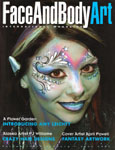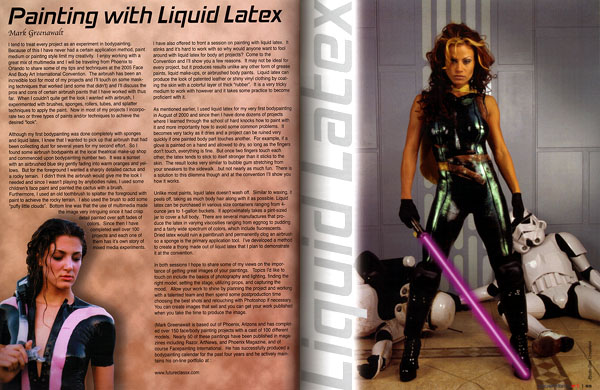

Originally published in FaceAndBodyArt, (January-June 2005)
I tend to treat every project as an experiment in bodypainting. Because of this I have never had a certain application method, paint medium or painting style limit my creativity. I enjoy working with a great mix of multimedia and I will be traveling from Phoenix to Orlando to share some of my tips and techniques at the 2005 Face And Body Art International Convention. The airbrush has been an incredible tool for most of my projects and I’ll touch on some masking techniques that worked (and some that didn’t) and I’ll discuss the pros and cons of certain airbrush paints that I have worked with thus far. When I couldn’t quite get the look I wanted with airbrush, I experimented with brushes, sponges, rollers, tubes, and splatter techniques to apply the paint. Now in most of my projects I incorporate two or three types of paints and/or techniques to achieve the desired “look”.

Although my first bodypainting was done completely with sponges and liquid latex, I knew that I wanted to pick up that airbrush that had been collecting dust for several years for my second effort. So I found some airbrush bodypaints at the local theatrical make-up shop and commenced upon bodypainting number two. It was a sunset with an airbrushed blue sky gently fading into warm oranges and yellows. But for the foreground I wanted a sharply detailed cactus and a rocky terrain. I didn’t think the airbrush would give me the look I needed and since I wasn’t playing by anybodies rules, I used some children’s face paint and painted the cactus with a brush. Furthermore, I used an old toothbrush to splatter the foreground with paint to achieve the rocky terrain. I also used the brush to add some “puffy little clouds”. Bottom line was that the use of multimedia made the image very intriguing since it had crisp detail painted over soft fades of colors. Since then I have completed well over 100 projects and each one of them has it’s own story of mixed media experiments.
I have also offered to front a session on painting with liquid latex. It stinks and it’s hard to work with so why would anyone want to fool around with liquid latex for body art projects? Come to the Convention and I’ll show you a few reasons. It may not be ideal for every project, but it produces results unlike any other form of grease paints, liquid make-ups, or airbrushed body paints. Liquid latex can produce the look of patented leather or shiny vinyl clothing by coating the skin with a colorful layer of thick “rubber”. It is a very tricky medium to work with however and it takes some practice to become proficient with it.
As mentioned earlier, I used liquid latex for my very first bodypainting in August of 2000 and since then I have done dozens of projects where I learned through the school of hard knocks how to paint with it and more importantly how to avoid some common problems. It becomes very tacky as it dries and a project can be ruined very quickly if one painted body part touches another. For example, if a glove is painted on a hand and allowed to dry, so long as the fingers don’t touch, everything is fine. But once two fingers touch each other, the latex tends to stick to itself stronger than it sticks to the skin. The result looks very similar to bubble gum stretching from your sneakers to the sidewalk…but not nearly as much fun. There is a solution to this dilemma though and at the convention I’ll show you how it works.
Unlike most paints, liquid latex doesn’t wash off. Similar to waxing, it peels off, taking as much body hair along with it as possible. Liquid latex can be purchased in various size containers ranging from 4-ounce jars to 1-gallon buckets. It approximately takes a pint-sized jar to cover a full body. There are several manufactures that produce the latex in varying viscosities ranging from eggnog to pudding and a fairly wide spectrum of colors, which include fluorescents. Dried latex would ruin a paintbrush and permanently clog an airbrush so a sponge is the primary application tool. I’ve developed a method to create a thong made out of liquid latex that I plan to demonstrate it at the convention.
In both sessions I hope to share some of my views on the importance of getting great images of your paintings. Topics I’d like to touch on include the basics of photography and lighting, finding the right model, setting the stage, utilizing props, and capturing the mood. Allow your work to shine by planning the project and working with a talented team and then spend some postproduction time choosing the best shots and retouching with Photoshop if necessary. You can create images that sell and you can get your work published when you take the time to produce the image.
(Mark Greenawalt is based out of Phoenix, Arizona and has completed over 150 face/body painting projects with a cast of 100 different models. Nearly 50 of these paintings have been published in magazines including Razor, ArtNews, and Phoenix Magazine, and of course Facepainting International. He has successfully produced a bodypainting calendar for the past four years and he actively maintains his on-line portfolio at
www.futureclassx.com .)
Click on the images below to enlarge them.
To see more of these bodypaintings, click on the following links:
http://www.futureclassx.com/bodypaint/alison/pinksuit/alisonswimsuit.htm
http://www.futureclassx.com/bodypaint/lynette/marajade/coppercon22.htm
Mark Greenawalt
http://www.futureclassx.com
